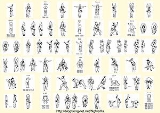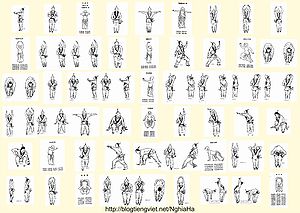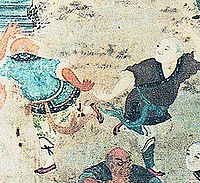
Yì Jin Jing
Encyclopedia

Qigong
Qigong or chi kung is a practice of aligning breath, movement, and awareness for exercise, healing, and meditation...
manual containing a series of exercises, coordinated with specific breathing and mental concentration, said to enhance physical health dramatically when practiced consistently. In the modern day there are many translations and distinct sets of exercises all said to be derived from the original (the provenance of which is the subject of some debate). These exercises are notable for being a key element of the physical conditioning used in Shaolin
Shaolin kung fu
Shaolin Kung Fu refers to a collection of Chinese martial arts that claim affiliation with the Shaolin Monastery.Of the multitude styles of kung fu and wushu, only some are actually related to Shaolin...
training.
Origins
According to legend, the Yijin Jing was said to be left behind by BodhidharmaBodhidharma
Bodhidharma was a Buddhist monk who lived during the 5th/6th century AD. He is traditionally credited as the transmitter of Ch'an to China, and regarded as the first Chinese patriarch...
after his departure from the Shaolin Monastery, and discovered within his grave (or hidden in the walls of the temple) years after he had left (or died). It was accompanied by another text, the Xisui Jing, which was passed to a student of Bodhidharma
Bodhidharma
Bodhidharma was a Buddhist monk who lived during the 5th/6th century AD. He is traditionally credited as the transmitter of Ch'an to China, and regarded as the first Chinese patriarch...
's but has not survived to the modern day.
The monks of Shaolin reportedly practiced the exercises within the text but lost the true purpose of the document; Lin reports the legend that they "selfishly coveted it, practicing the skills therein, falling into heterodox ways, and losing the correct purpose of cultivating the Way. The Shaolin monks have made some fame for themselves through their fighting skill; this is all due to having obtained this manuscript."
Both documents were written in an Indian language which was not well-understood by the monks of the temple; apparently one monk decided that the text must contain more valuable knowledge than simply self-defense, and went on a pilgrimage with a copy of the text to find someone who could translate the deeper meaning of the text. He eventually met an Indian priest named Pramati in the province of Szechwan who, examining the text, explained that the meaning of the text was extraordinarily deep and beyond his ability to translate fully. He nonetheless provided a partial translation. The monk found that within a year of practicing the techniques as Pramati had translated, that his constitution had become "as hard as steel," and he felt that he could be a Buddha. The monk was so pleased that he thereafter followed Pramati wherever he went.
Modern Scholarly Research
The legendary account may spring from two prefaces which accompany the Yijin Jing. One of these prefaces purports to be written by the general Li JingLi Jing
Li Jing , né Yaoshi , formally Duke Jingwu of Wei , was a general and one time chancellor of the Chinese Tang Dynasty...
in 628 during the Tang Dynasty
Tang Dynasty
The Tang Dynasty was an imperial dynasty of China preceded by the Sui Dynasty and followed by the Five Dynasties and Ten Kingdoms Period. It was founded by the Li family, who seized power during the decline and collapse of the Sui Empire...
, while the other purports to be written by the general Niu Gao, a junior officer of the Song Dynasty
Song Dynasty
The Song Dynasty was a ruling dynasty in China between 960 and 1279; it succeeded the Five Dynasties and Ten Kingdoms Period, and was followed by the Yuan Dynasty. It was the first government in world history to issue banknotes or paper money, and the first Chinese government to establish a...
General Yue Fei
Yue Fei
Yue Fei , style name Pengju, was a military general of the Southern Song Dynasty. His ancestral home was in Xiaoti, Yonghe Village, Tangyin, Xiangzhou, Henan...
. However, there are several inaccuracies and inconsistencies in these forewords that cast doubt on the authenticity of the Yijin Jing.
It was specifically the foreword by Li Jing to which Tang Hao traced the attribution of Shaolin Kung Fu to Bodhidharma.
Li Jing's foreword refers to "the tenth year of the Taihe period of Emperor Xiaoming of Northern Wei
Emperor Xiaoming of Northern Wei
Emperor Xiaoming of Northern Wei , personal name Yuan Xu , was an emperor of the Chinese/Xianbei dynasty Northern Wei...
." The Taihe reign period did not occur under Emperor Xiaoming but under Emperor Xiaowen
Emperor Xiaowen of Northern Wei
Emperor Xiaowen of Northern Wei , personal name né Tuoba Hong , later Yuan Hong , was an emperor of the Chinese/Xianbei dynasty Northern Wei....
and, in its tenth year (487 CE), the Shaolin temple did not yet exist according to the Jiaqing Chongxiu Yitongzhi, which states that the Shaolin temple was built in the twentieth year of the Taihe era (497 CE), though the Jiaqing Chongxiu Yitongzhi was itself compiled much later in 1820. Li Jing's foreword also claims that he received the manual containing the exercise from the "Bushy Bearded Hero" (虬髯客, Qiuran ke), a popular fictional character from a Tang Dynasty
Tang Dynasty
The Tang Dynasty was an imperial dynasty of China preceded by the Sui Dynasty and followed by the Five Dynasties and Ten Kingdoms Period. It was founded by the Li family, who seized power during the decline and collapse of the Sui Empire...
story of the same name by Du Guangting (850-933).
Niu Gao's foreword mentions the Qinzhong temple, which wasn't erected until 20 years after the date he claims to be writing.
He also claims to be illiterate.
Dictation could resolve the question of how an illiterate could write a foreword, but it is almost certain that a general of Niu Gao's stature was not illiterate.
During the 18th century, the scholar Ling Tingkan concluded that the author of the Yijin Jing must have been an "ignorant village master".
Matsuda Ryuchi could attest to the existence of the Yijin Jing only as far back as 1827.
Lin Boyuan attributes the Yì Jīn Jīng to the Taoist priest Zining writing in 1624.
In the course of his research, Matsuda found no mention of—let alone attribution to—Bodhidharma in any of the numerous texts written about the Shaolin martial arts before the 19th century.
The Yijin Jing appears to be the source for two other popular Qigong forms which are also attributed to various authors. Both the Eighteen Luohan Hands (also associated with Shaolin) and the Eight Pieces of Brocade (Baduanjin) forms seem like abridged versions of Yijinjing sets. The Baduanjin is sometimes attributed to Yue Fei
Yue Fei
Yue Fei , style name Pengju, was a military general of the Southern Song Dynasty. His ancestral home was in Xiaoti, Yonghe Village, Tangyin, Xiangzhou, Henan...
. Of the many versions of all 3 of the above, some also contain forms from the older Wuqin, or Five Animal Frolics of Hua Tuo
Hua Tuo
Hua Tuo was an ancient Chinese physician who lived during the late Han Dynasty and Three Kingdoms era of Chinese history. The Records of Three Kingdoms and Book of Later Han record Hua as the first person in China to use anesthesia during surgery. He used a general anesthetic combining wine with a...
.
Other sources around the ’50s claim that Yijin Jing was born from the farmers and the people working hard on the fields, and that these exercises would help them in their daily work and are derived from that country life style. Although this claim can be easily brought to political reasons, this is still another possibility. Classic Chinese authors tend to insist on the ancient lineage of this practice, but there is no evidence of the connections to Shaolin systems or to a specific routine.
Yijin Jing – The Forms

Tradition YiJinJing form demonstrated by ShaoLin Monk Shi DeQuan with illustration.
The 12 Posture Moving Exercise kept to this day is something that Wang Zuyuan learned at Shaolin Monastery on Mount Song
Mount Song
Mount Song, known in Chinese as Song Shan , is one of the Five Sacred Mountains of Taoism and is located in Henan province on the south bank of the Yellow River in China...
. It is somewhat different from the original "Picture of stationary exercise" and "Guide to the art of attack" (as Guangdong
Guangdong
Guangdong is a province on the South China Sea coast of the People's Republic of China. The province was previously often written with the alternative English name Kwangtung Province...
sources refers). Some specialists (Liu Dong) refer of a later integration of Yijin Jing, Daoyin, Tuna and Xingqi methods. However Wang's 12 Postures found to be concise through practice and helps to enhance one's physical health. As the name implies, "sinew transforming exercise" is the method to train the tendons and muscles. The exercise is designed according to the course and the characteristics of Qi circulation in the 12 regular channels and Du and Ren channels. During practice, Qi and blood usually circulates appropriately with proper speed and no sluggishness or stagnation. Because of this efficacy, Yijin Jing has existed for centuries as a favorite with the populace and is still widely used in sanatoria and hospitals for therapeutic purposes. Two ancient written and illustrated routines remained, one from Chen Yi's "A collection of Annals" published during the Ming Dynasty
Ming Dynasty
The Ming Dynasty, also Empire of the Great Ming, was the ruling dynasty of China from 1368 to 1644, following the collapse of the Mongol-led Yuan Dynasty. The Ming, "one of the greatest eras of orderly government and social stability in human history", was the last dynasty in China ruled by ethnic...
and another more recent published in 1882, from "Internal Work Illustrated", that of Wang Zuyuan.
The 12 Posture Moving Exercise most closely describes what is called the 12 fists of Bodhidharma in Many southern martial arts most notably Hung Gar
Hung Gar
Hung Ga 洪家, Hung Kuen 洪拳, or Hung Ga Kuen 洪家拳 is a southern Chinese martial art associated with the Chinese folk hero Wong Fei Hung, who was a master of Hung Ga....
and Wing chun
Wing Chun
Wing Chun , also romanised as Ving Tsun or Wing Tsun, ; ; is a concept-based Chinese martial art and form of self-defense utilizing both striking and grappling while specializing in close-range combat.The alternative characters 永春 "eternal spring" are also...
. Ascribing the 12 exercises to 12 animals that Bodhidharma studied after his 9 years of meditation. The exercises were developed based on the movements of the 12 animals. These exercises healed the sickly monks of Shaolin Monastery, and contribute to the many animal based martial arts in China.
Purposes of Yijin Jing
The basic purpose of Yijin Jing is to turn flaccid and frail sinews and tendons into strong and sturdy ones. The movements of Yijin Jing are at once vigorous and gentle. Their performance calls for a unity of will and strength, i.e. using one's will to direct the exertion of muscular strength. It is coordinated with breathing.Better muscles and tendons means better health and shape, more resistance, flexibility, and endurance. It is obtained as follows:
- postures influence the static and nervous structure of the body
- stretching muscles and sinews affects organs, joints, meridians and Qi
- torsion affects metabolism and Jing production
- breathing produces more and better refined Qi
- active working gives back balance and strength to body and mind (brain, nervous system and spirit).
Power and endurance are of paramount importance if we look at becoming qualified in whatever practice we choose, be it Tuina, martial arts, or simply better health and wisdom. Already another known Qigong system, Baduanjin, in its more radical and strong forms was used in the past from schools of Xingyiquan and Tijiquan as bodily preparation to fighting arts, in order to make body strong and flexible. Baduanjin still remains the first, entry-level routine to learn at Shaolin training schools in Song Mountains. We can still see today Japanese Kata like Sanchin, postures and forms like Siunimtao in Wingchung, "Iron thread" in Hung Gar and all sorts of Neigong in Neijia
Neijia
Nèijiā is a term in Chinese martial arts, grouping those styles that practice nèijìng , usually translated as internal martial arts, occupied with spiritual, mental or qi-related aspects, as opposed to an "external" approach focused on physiological aspects...
. Martial artists need to be powerful in the martial practice, like non-martial people need to be healthy. But there is also something supple and flexible inside of Yijin Jing. Movements are energetic and intense, but you can see through a kind of peace. Yijin Jing unifies in fact Yi (intention) with Li (strength), consciousness (yang) with muscular force (yin). The mind is free from thoughts, has a correct and well-disposed attitude, the breathing is harmonious. Internal and external movement must be coordinated, like movement with relaxation. Externally must be fortification; inside must be purification; unifying matter and spirit.
Some classic recurring points of Yijin Jing can be described as follows:
- Most of the movements use open palms, fists are used only for stretching the tendons.
- The names of exercises change, but often the basic idea of movement remains the same. I.e. Wei Tuo greets and offers something (Nanjing Ac. of Tuina); Wei Tuo offers gifts to the sky (Liu Dong); General Skanda holds the Cudgel (Zong Wu-Li Mao).
- Movements are done standing, sometimes bending forward, but never lying or sitting.
- Eyes are always open, never closed.
- Movements are slow but full and tensed, face and body shows relaxed attitude.
- All directions of the upper body section (especially shoulders) are active and moved.
- Dynamic tension rules the moves.
- All parts of the body work together.
- There are different ways of practicing the same Yijinjing form, according to the basic rules, to the body shape, to the time of practice and to the general health conditions.
According to traditional verbal formulas, we have that:
- The first year of training gives back physical and mental vitality.
- The second year enhances blood circulation and nurtures meridians.
- The third year allows flexibility to muscles and nurtures the organs.
- The fourth year improves meridians and nurtures viscera.
- The fifth year washes the marrow and nurtures the brain.
The Five rules of Yijin Jing are:
Quietness
- Like lake water reflects the moon, a calm spirit allows energy to move inside the body.
Slowness
- In order to use and flex muscles deeply, to get maximum extension and move Qi and Xue, slow movements are required.
Extension
- Each movement must be brought to the maximum.
Pause
- Efficacy comes through waiting and keeping tension for a longer time.
Flexibility
- Limbs and trunk must be extended so that blood and energy can circulate, so we have flexibility.
Breathing in Yijin Jing is a controversial point. Modern sources insist on a deep, forced, reverse breathing in order to develop power. Other sources, and among them Robert W. Smith, in his article on the J.A.M.A. in 1996, suggest that there are differences between the northern and the southern way of breath. The southern systems seem not to have a deep understanding and good use of breathing and working on Qi as energy. In his work on "Breathing in Taiji and other fighting arts", Smith analyses not only Taiji veterans and classics, but also known fighters out of his personal experience, and invariably the right kind of breathing, be it for martial or for health purposes, is located between classic abdominal breathing and a slow, unconscious breathing, where there is place for sudden explosions, typical of martial arts and hard blows.
Popular culture
The Yijin Jing is featured in Louis Cha's WuxiaWuxia
Wuxia is a broad genre of Chinese fiction concerning the adventures of martial artists. Although wuxia is traditionally a form of literature, its popularity has caused it to spread to diverse art forms like Chinese opera, manhua , films, television series, and video games...
novel The Smiling, Proud Wanderer
The Smiling, Proud Wanderer
The Smiling, Proud Wanderer is a wuxia novel by Jin Yong, first published as a serial in Ming Pao from April 20, 1967 to October 12, 1969. The term "Xiaoao Jianghu" means to live a carefree life in a mundane world of strife...
. In the story, abbot Fangzheng of the Shaolin Sect
Shaolin Sect
The Shaolin Sect is a fictional Chinese martial arts sect featured in several wuxia works. It is one of the largest, most famous and recognised orthodox and righteous sects in the jianghu. Its home base is at present-day Shaolin Monastery in Henan...
teaches Linghu Chong
Linghu Chong
Linghu Chong is the fictional protagonist of the wuxia novel The Smiling, Proud Wanderer by Jin Yong.-Biography:Linghu is an orphan and was taken into Yue Buqun's care as a child. Yue accepted him as a disciple and Linghu became a member of the Mount Hua Sect as Yue's most senior disciple. He...
(the protagonist) how to use the skills described in the Yijin Jing to heal his internal injuries.

